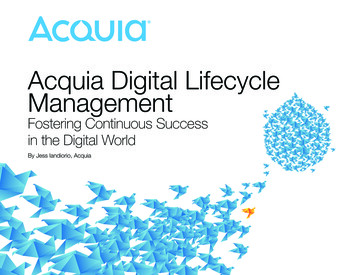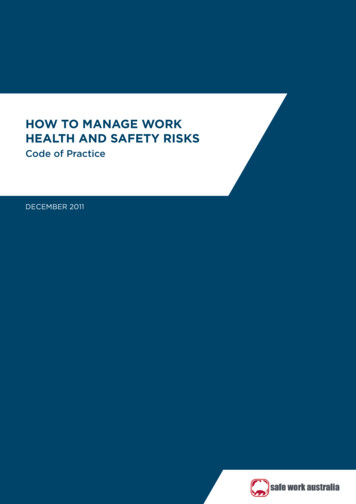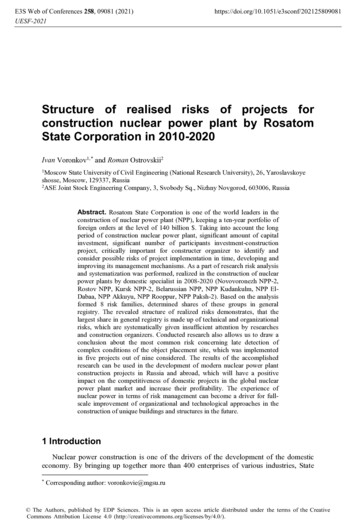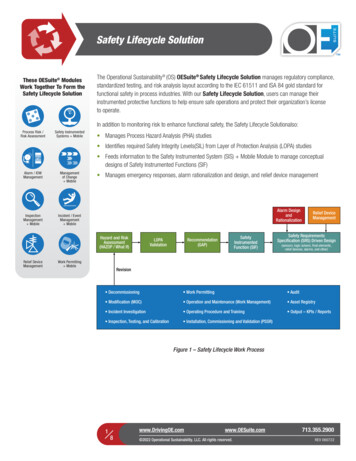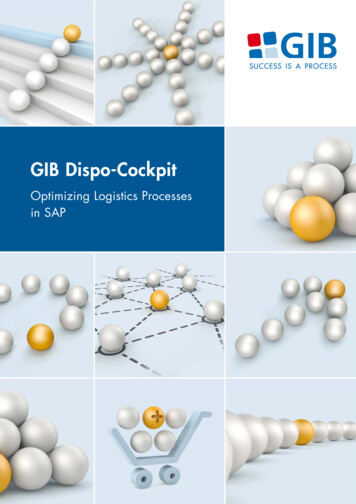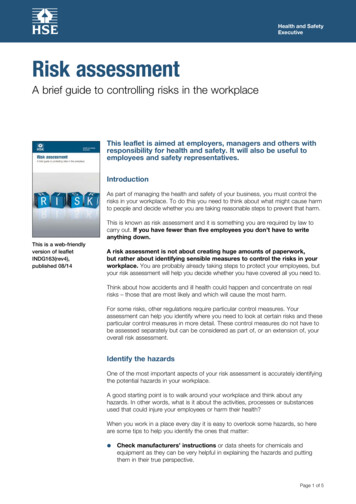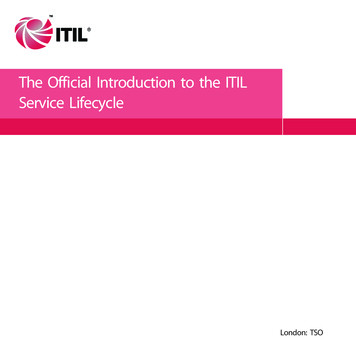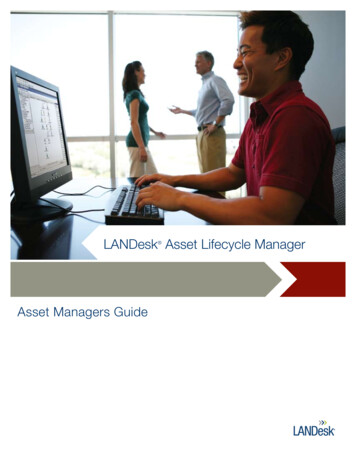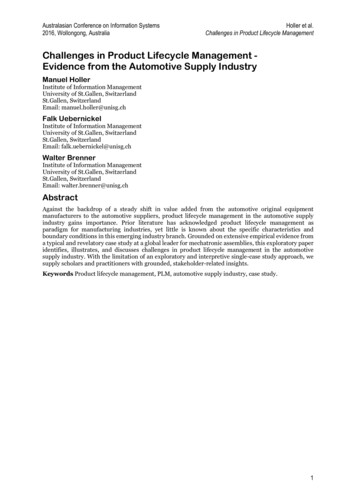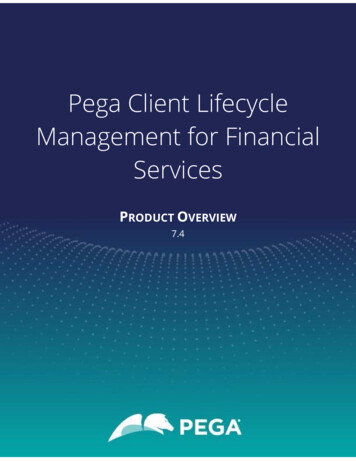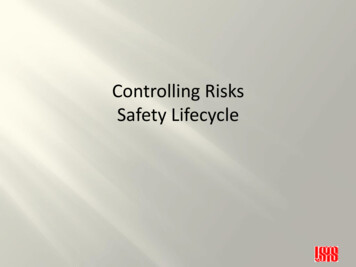
Transcription
Controlling RisksSafety Lifecycle
Objective– Introduce the concept of a safety lifecycle and theapplicability and context in safety systems.USPAS January 2012Controlling Risks: Safety Systems
Lifecycle Management A risk based management plan for a system orsubsystem from conception todecommissioning. (and re-commissioning)USPAS January 2012Controlling Risks: Safety Systems
Standards - IEC61508 (part 7.1) structure, in a systematic manner,the phases in the overall safety lifecycle thatshall be considered in order to achieve therequired functional safety of the E/E/PEsafety-related systems. document key information relevant to thefunctional safety of the E/E/PE safety-relatedsystems throughout the overall safetylifecycle.USPAS January 2012Controlling Risks: Safety Systems
IEC 61508 DefinitionSafety Lifecycle (IEC 61508)necessary activities involved in theimplementation of safety-related systems,occurring during a period of time that starts atthe concept phase of a project and finishes whenall of the E/E/PE safety-related systems, othertechnology safety-related systems and externalrisk reduction facilities are no longer availablefor use.USPAS January 2012Controlling Risks: Safety Systems
Standards - IEC61511 (part 6) define the phases and establish therequirements of the safety life-cycle activities; organize the technical activities into a safety life cycle; ensure that adequate planning exists (or is developed)that makes certain that the safety instrumented systemshall meet the safety requirements. (part 7) demonstrate by review, analysis and/or testingthat the required outputs satisfy the definedrequirements for the appropriate phases of the safetylife cycle identified by the verification planning.USPAS January 2012Controlling Risks: Safety Systems
IEC 61511 DefinitionSafety Lifecycle (IEC 61511)necessary activities involved in theimplementation of safety instrumentedfunction(s) occurring during a period of timethat starts at the concept phase of a projectand finishes when all of the safetyinstrumented functions are no longer availablefor useUSPAS January 2012Controlling Risks: Safety Systems
MIL-STD-882d Definition Life cycle, All phases of the system's lifeincluding design, research, development, testand evaluation, production, deployment(inventory), operations and support, anddisposal.’USPAS January 2012Controlling Risks: Safety Systems
Safety Lifecycle Approach The safety lifecycleapproach, as described inISA 84.01, IEC 61511, andIEC 61508: utilizes common sense is a closed loop process Is continuous/has no endUSPAS January 2012Controlling Risks: Safety Systems
Quality Systems ApproachUSPAS January 2012Controlling Risks: Safety Systems
ISO & IEC ComparisonIEC ModelUSPAS January 2012ISO ModelControlling Risks: Safety Systems
Safety Lifecycle Model Divided into three phases Analysis Phase - the problem is identified andassessed Realization Phase – the problem is solved andverified Operational Phase – the solution is put into useUSPAS January 2012Controlling Risks: Safety Systems
USPAS January 2012Controlling Risks: Safety Systems
IEC 61511 LifecycleRisk analysis and protection layer designAllocation of safety functionsto safety instrumented systemsor other means of risk reductionManagementof functionalSafety ningSafety requirementsspecificationfor the SISDesign and developmentofOther means of riskreductionDesign and developmentofSafety InstrumentedSystemInstallation, commissioning, and validationOperation and maintenanceModificationUSPAS January 2012DecommissioningControlling Risks: Safety SystemsVerification
IEC61508 LifecycleAnalysisRealizationOperationUSPAS January 2012Controlling Risks: Safety Systems
Analysis Phase Concept– Develop an understanding of the equipment under control& its environment (physical & legal)– Determine likely hazard sources– Collect info on determined hazards (radiation, RF,electricity, )– Hazard interaction with other equipment Scope Definition– Determine process/system boundaries– Determine the scope of hazardsUSPAS January 2012Controlling Risks: Safety Systems
Analysis Phase (continued) Scope Definition– Determine the physical equipment to be includedin hazard/risk analysis– Determine the subsystems associated w/ thehazards– Determine what external events will be included– Determine types of accident-initiating eventsUSPAS January 2012Controlling Risks: Safety Systems
Analysis Phase (continued) Hazard & Risk Analysis Develop hazards list & events- Includes fault conditions & misuse- Abnormal & infrequent operation modes Determine event sequences Determine the likelihood & consequences for eachevent Evaluate the riskUSPAS January 2012Controlling Risks: Safety Systems
Analysis Phase (continued) Overall Safety Requirements– Specify necessary safety functions Functions will not be defined in technology-specificterms– Determine necessary risk reduction Qualitative or quantitative– Determine safety integrity requirement for eachsafety function This is an interim stage toward determining SILsUSPAS January 2012Controlling Risks: Safety Systems
Analysis Phase (continued) Safety Requirements Allocation– Specify safety-related systems to be used External risk reduction facilities E/E/PE safety-related systems Other technology safety-related systems– Allocate safety integrity level to each E/E/PE safety-relatedsystem Done after taking into account risk reductions from external riskfacilities and other technology safety-related systems– Ends with a Safety Requirements Specification documentUSPAS January 2012Controlling Risks: Safety Systems
Realization Phase Technology & Architecture selections Determine test philosophy Perform reliability and safety evaluation todetermine if you met your target SIL requirement Develop SIS conceptual design Prepare detailed design document (wiringdiagrams; installation plans, etc.) Install system, commission, & performacceptance testingUSPAS January 2012Controlling Risks: Safety Systems
IEC61508 Realization PhaseUSPAS January 2012Controlling Risks: Safety Systems
Operations Phase Design Validation Does the system solve the problems identified during thehazard analysis? Have all necessary design steps been carried outsuccessfully? Has the design met the target SIL for each safetyinstrumented function? Have the maintenance procedures been created andverified? Is there a management of change procedure in place? Are operators and maintenance personnel qualified andtrained?USPAS January 2012Controlling Risks: Safety Systems
Operations Phase Lifecycle continues with evaluations of systemmodifications and decommissioning activities Validation reviews the safety lifecycle activitiesand ensures that all steps were carried outand documentation is in placeUSPAS January 2012Controlling Risks: Safety Systems
Summary The safety lifecycle was created to– help safety instrumented system designers build safersystems– help create more cost effective systems Various lifecycle models exist but contain similarsteps Documentation at every step is key to managing yoursystem effectivelyUSPAS January 2012Controlling Risks: Safety Systems
requirements of the safety life-cycle activities; organize the technical activities into a safety life cycle; ensure that adequate planning exists (or is developed) that makes certain that the safety instrumented system shall meet the safety requirements. (part 7) demonstrate by review, analysis and/or testing
